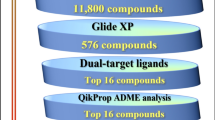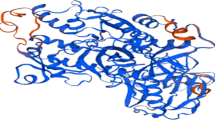Abstract
Visceral leishmaniasis (VL: a fatal disease) is reported to occur at the rate of 70,000 to 90,000 per year, according to WHO. VL is caused by Leishmania donovani species causing 90% cases of VL. Current treatment regime is not satisfactory due to substantial toxic side effects of existing antileishmanial therapy and the emergence of drug resistance from different part of the world. These issues make existing therapy unsuitable management of VL. There are various studies dedicated to overcoming the shortcomings in antileishmanial therapeutics. Likewise, in this study, we have targeted HSP100 (heat shock protein) of L. donovani for identification of potent antileishmanial. HSP100 protein is released when the Leishmania parasite encounters heat stress in macrophage of mammalian host making it an effective target. This in silico study was carried out with 10 unexplored ligands and Miltefosine (an established anti-leishmanial drug used as control) via targeting L. donovani HSP100. We report that two test ligands Diospyrin and Benzoxaborole had outstanding docking potential with L. donovani HSP100 and were chosen for further analysis of drug-likeness and ADMET (absorption distribution, metabolism, and excretion) properties. These two ligands docking scores were better than the antileishmanial Miltefosine and had better ADMET properties as a drug candidate. The result gave us a lead and confirmation to support our hypothesis that HSP100 can be a potential drug target of L. donovani and Diospyrin and Benzoxaborole can be potent antileishmanial molecules.







Similar content being viewed by others
Abbreviations
- VL:
-
Visceral Leishmaniasis
- HSP:
-
Heat shock protein
- CMC:
-
Comprehensive medical chemistry
- MDDR:
-
Modern drug data report
- WDI:
-
World drug Index
- ADME:
-
Absorption distribution, metabolism and excretion
- MDCK:
-
Madin Darby canine kidney
- HERG:
-
human ether a go-go inhibition
References
Darcis G, Van der Auwera G, Giot J-B et al (2017) Recurrence of visceral and muco-cutaneous leishmaniasis in a patient under immunosuppressive therapy. BMC Infect Dis 17:478. https://doi.org/10.1186/s12879-017-2571-x
de Melo EC, Fortaleza CMCB (2013) Challenges in the therapy of visceral leishmaniasis in Brazil: a public health perspective. J Trop Med 2013:319234. https://doi.org/10.1155/2013/319234
Doehl JSP, Bright Z, Dey S et al (2017) Skin parasite landscape determines host infectiousness in visceral leishmaniasis. Nat Commun 8:57. https://doi.org/10.1038/s41467-017-00103-8
Ekins S, Rose J (2002) In silico ADME/Tox: the state of the art. J Mol Graph Model 20:305–309. https://doi.org/10.1016/S1093-3263(01)00127-9
Halgren TA (2009) Identifying and characterizing binding sites and assessing druggability. J Chem Inf Model 49:377–389. https://doi.org/10.1021/ci800324m
Jessen L, Bard B, Grenon X, Bally F (2016) Leishmaniasis : an infection of travellers and migrants. Rev Med Suisse 12:1718–1722
Jha A, Kumar A (2016) Development and targeting of transcriptional regulatory network controlling FLU1 activation in Candida albicans for novel antifungals. J Mol Graph Model 69:1–7. https://doi.org/10.1016/j.jmgm.2016.07.009
Jha A, Kumar A (2018) Deciphering the role of sodium lignosulfonate against Candida spp. as persuasive anticandidal agent. Int J Biol Macromol 107:1212–1219. https://doi.org/10.1016/j.ijbiomac.2017.09.102
Jha A, Kumar A (2019) Multiple drug targeting potential of novel ligands against virulent proteins of Candida albicans. Int J Pept Res Ther:1–22. https://doi.org/10.1007/s10989-019-09897-1
Jha A, Vimal A, Bakht A, Kumar A (2018) Inhibitors of CPH1-MAP kinase pathway: ascertaining potential ligands as multi-target drug candidate in Candida albicans. Int J Pept Res Ther:1–14. https://doi.org/10.1007/s10989-018-9747-0
Kim LS, Kim JH (2011) Heat shock protein as molecular targets for breast cancer therapeutics. J Breast Cancer 14:167–174. https://doi.org/10.4048/jbc.2011.14.3.167
Krobitsch S, Brandau S, Hoyer C et al (1998) Leishmania donovani heat shock protein 100. Characterization and function in amastigote stage differentiation. J Biol Chem 273:6488–6494
Pandey SC, Jha A, Kumar A, Samant M (2019) Evaluation of antileishmanial potential of computationally screened compounds targeting DEAD-box RNA helicase of Leishmania donovani. Int J Biol Macromol 121:480–487. https://doi.org/10.1016/J.IJBIOMAC.2018.10.053
Peng QX, Guan XH, Yi ZG, Su YP (2014) Insilico approaches in anesthetic drug development: Computer aided drug designing. Drug Res (Stuttg) 8. https://doi.org/10.1055/s-0034-1395564
Romero GAS, Costa DL, Costa CHN et al (2017) Efficacy and safety of available treatments for visceral leishmaniasis in Brazil: a multicenter, randomized, open label trial. PLoS Negl Trop Dis 11:e0005706. https://doi.org/10.1371/journal.pntd.0005706
Singh S, Sivakumar R (2004) Challenges and new discoveries in the treatment of leishmaniasis. J Infect Chemother 10:307–315. https://doi.org/10.1007/s10156-004-0348-9
Singh A, Kaushik R, Mishra A et al (2016) ProTSAV: a protein tertiary structure analysis and validation server. Biochim Biophys Acta - Proteins Proteomics 1864:11–19. https://doi.org/10.1016/j.bbapap.2015.10.004
Torres-Guerrero E, Quintanilla-Cedillo MR, Ruiz-Esmenjaud J, Arenas R (2017) Leishmaniasis: a review. F1000Research 6:750. https://doi.org/10.12688/f1000research.11120.1
Tubert-Brohman I, Sherman W, Repasky M, Beuming T (2013) Improved docking of polypeptides with glide. J Chem Inf Model 53:1689–1699. https://doi.org/10.1021/ci400128m
Acknowledgments
Authors are thankful to the Department of Biotechnology, National Institute of Technology Raipur (CG), India for providing facility, space, and resources for this work.
Author information
Authors and Affiliations
Corresponding author
Ethics declarations
Conflict of interest
None.
Additional information
Publisher’s note
Springer Nature remains neutral with regard to jurisdictional claims in published maps and institutional affiliations.
Rights and permissions
About this article
Cite this article
Jha, A., Verma, S. & Kumar, A. Identification of potential inhibitors targeted for strengthening search of anti-leishmanial therapeutics. Biologia 75, 437–445 (2020). https://doi.org/10.2478/s11756-019-00360-6
Received:
Accepted:
Published:
Issue Date:
DOI: https://doi.org/10.2478/s11756-019-00360-6




